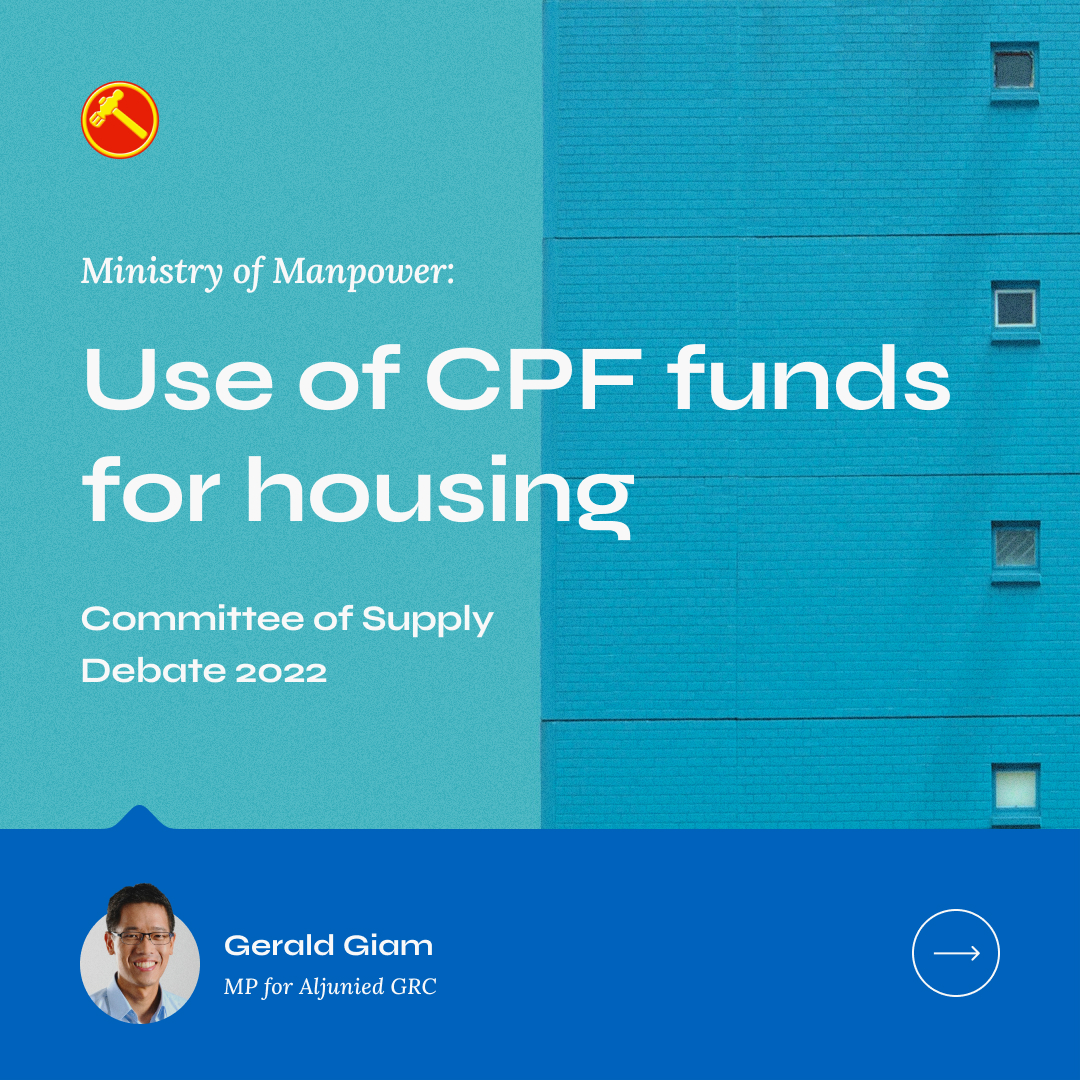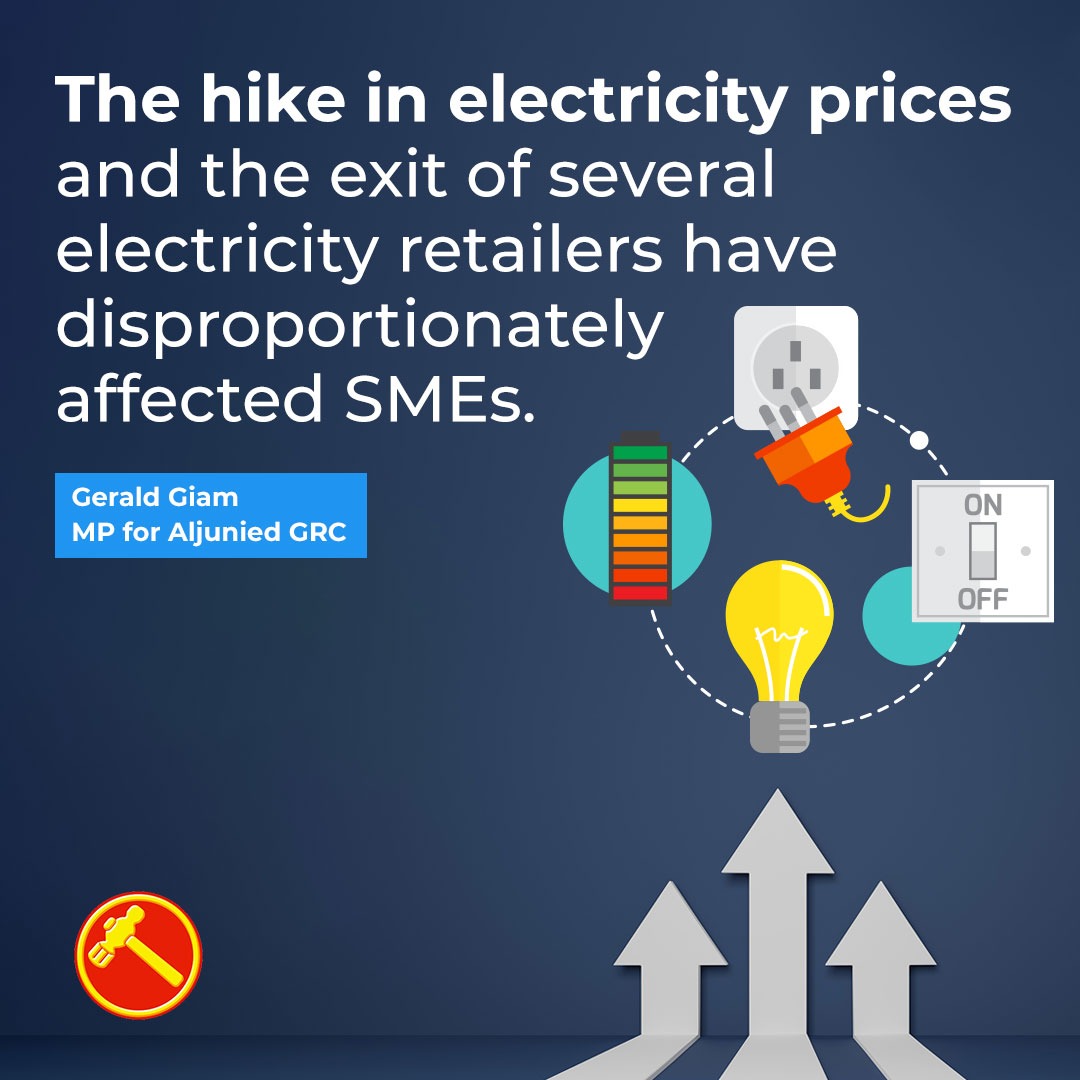Several business owners in my constituency, including kopitiam operators, shared with me their shock at seeing their electricity bills jump more than threefold since October 2021. This was despite their efforts to reduce electricity usage. Many are facing difficulties managing the sky high electricity costs.
SMEs are disproportionately affected by the exit of electricity retailers and the drastic increase in the wholesale electricity price. They are not offered fixed tariff price plans by SP Group, and most retailers are not offering such contracts at this time.
On 14 February 2022, I asked the Minister for Trade and Industry for an update on EMA’s Temporary Electricity Support Scheme (TRECS). TRECS was oversubscribed when it was launched in January 2022.
I also asked whether EMA will consider working with electricity retailers to provide a 12-month fixed electricity plan for smaller business consumers, specifically SMEs with a monthly consumption between 4,000 and 20,000 kWh.
I further asked if EMA could extend TRECS for another six to 12 months beyond May 2022, in view of the current economic situation and energy supply situation. If this was not possible, I asked if EMA could allow these SMEs to buy electricity at the regulated tariff instead, so that their operational costs do not skyrocket.
This is the full text of my question and exchange in Parliament with the Minister:
UPDATE ON TEMPORARY ELECTRICITY CONTRACTING SUPPORT SCHEME AND IMPACT OF EXIT OF ELECTRICITY RETAILERS ON SMES AND SUPPORT AVAILABLE
The following question stood in the name of Mr Edward Chia Bing Hui –
41 To ask the Minister for Trade and Industry (a) to date, what is the take-up rate of the Temporary Electricity Contracting Support Scheme (TRECS); (b) what is the number of companies not supported by TRECS; (c) what is the cost delta impact on these companies and the reasons for not being supported; and (d) whether the Ministry intends for TRECS to continue for an extended period of time.
42 Ms Sylvia Lim asked the Minister for Trade and Industry (a) what is the Ministry’s assessment of the effect of the exit of various electricity retailers in 2021 on the electricity bills of small and medium enterprises (SMEs); and (b) how is the Government monitoring or managing the capacity of the remaining retailers so as to facilitate SMEs having options to manage their electricity costs.
43 Ms Jessica Tan Soon Neo asked the Minister for Trade and Industry in light of five electricity retailers ceasing operations last year and many small and medium businesses (SMEs) having to shift back to SP Services’ wholesale electricity plan, what support can be extended to these SMEs to provide more certainty to manage their business costs against very high increases in their monthly electricity charges, particularly those with average monthly electricity consumption of 4,000 kWh and above.
44 Mr Gerald Giam Yean Song asked the Minister for Trade and Industry (a) whether he can provide an update on the Temporary Electricity Support Scheme (TRECS) since it was introduced in December 2021; (b) whether the TRECS will be extended beyond February 2022; and (c) whether EMA will consider working with electricity retailers to provide a 12-month fixed electricity plan for smaller business consumers, specifically SMEs with a monthly consumption between 4,000 and 20,000 kWh.
45 Ms He Ting Ru asked the Minister for Trade and Industry (a) what support is available to SMEs; and (b) what are the options available to affected businesses, when their utilities costs have increased by large factors due to the insolvency of their previous utilities retailers.
Ms Jessica Tan Soon Neo (East Coast): Question No 41, please.
The Second Minister for Trade and Industry (Dr Tan See Leng) (for the Minister for Trade and Industry): Mr Speaker, may I have your permission to answer Question Nos 41 to 45, as well as the Parliamentary Question filed by Mr Saktiandi Supaat1 that has been scheduled for a subsequent Sitting?
Mr Speaker: Yes, please.
Dr Tan See Leng: Mr Speaker, the world has been facing a global energy crunch since September last year. The price of LNG, or spot Liquefied Natural Gas, rose significantly and remains elevated at more than three times the levels as at the start of 2021.
While our piped natural gas (PNG) supply typically helps to moderate the impact from higher LNG prices, there was a series of disruptions and planned depletions to our PNG supply since the second half of 2021. This confluence of factors has resulted and caused increased volatility in wholesale electricity prices. Since October 2021, EMA, or the Energy Market Authority, has implemented a set of measures to enhance Singapore’s energy security and stabilise the SWEM, or Singapore Wholesale Electricity Market, prices.
Nevertheless, some market participants were adversely affected by the volatility. Between October and December 2021, six electricity retailers exited the market and another two retailers prematurely terminated some of their customers’ contracts. As a result, about 9% of all electricity consumer accounts were affected.
All affected households and businesses with an average monthly consumption of less than four megawatt hour (MWh) can switch to Singapore Power’s regulated tariff at any time. Some businesses consuming four MWh or more managed to secure plans with other retailers.
There remains about 11,000 business consumer accounts – accounting for about 1% of consumers – which have to buy electricity directly from the Singapore Wholesale Electricity Market, or SWEM, and are thus exposed to more volatile electricity prices.
To help these businesses, EMA worked with the generating companies or gencos to offer monthly fixed price plans under the Temporary Electricity Contracting Support Scheme, or TRECS for short, in January this year – that is last month. The TRECS plans were fully subscribed for January. For the month of February, the initial offering of TRECS was also fully subscribed. In response to requests for more such contracts, EMA worked with gencos and electricity retailers to offer about 645 megawatts of TRECS and other plans with significant fixed price components. At least 200 megawatts of the contracts are still available and we are extending TRECS for March, April and May.
We encourage all consumers without a retail plan to consider taking up these contracts for greater certainty.
Mr Speaker, let me now turn to the issue of electricity prices. Singapore imports all of our energy and cannot be fully insulated from developments in the global energy market. Well, let me make a correction – Singapore imports a vast majority of our energy, not all of our energy. We still have some from solar. The higher fuel prices feed into our electricity bills to reflect the higher costs of electricity production.
As I had mentioned during the Committee of Supply debates last year, we had been enjoying artificially low electricity prices for several years, because this is due to an over-investment in capacity and fuel by the generation companies. I have also alluded to the fact that that was also below the cost of generating electricity; and thus, it was not sustainable. In fact, if Members of the House remember, I also put up a chart that clearly demarcated and showed that the cost of generation was higher than the cost of the electricity tariffs at that time.
An electricity price correction was therefore unavoidable and the current global energy crunch has precipitated and exacerbated this correction.
Again, Members of this House would have asked what help is therefore available for the affected businesses. Household and small consumers which need help with their electricity bills can apply to SP Services for instalment payment plans. Businesses which need financing support can also make use of ESG’s programmes such as the Temporary Bridging Loan and Enterprise Financing Scheme SME Working Capital Loan.
The 11,000 or so business accounts without a long-term retail contract bear the brunt of the electricity crunch. To help them weather the storm, EMA has worked with gencos and electricity retailers to reduce the volatility and lower the cost of buying electricity through TRECS, additional monthly contracts offered by gencos, and on the wholesale market for businesses, as I had mentioned earlier. For example, Sembcorp Power Pte Ltd is offering one-month fixed price plans at preferred rates to consumers with average monthly consumption of between four and eight MWh.
EMA will also continue to monitor closely market developments, including heightened geopolitical tensions and their potential impact on global energy prices, and put in place the necessary measures to secure our energy supply, enhance stability and ensure the orderly functioning of the market.
Mr Speaker, Singapore has an open and competitive electricity market where prices will rise and fall depending on demand and supply conditions and developments in the global energy market. Over the last 20 years, our energy market has served us well. Our electricity supply is one of the most reliable and price competitive amongst major developed cities.
Our energy market is now being tested by unprecedented shocks and volatility in the global energy markets. Nevertheless, we are committed to ensuring that Singapore’s power supply remains secure and reliable, and to supporting our vulnerable customers during this period.
My only exhortation and urging is for all consumers to use energy prudently and to adopt energy conservation as a way of life. We will also learn from this episode to see how we can strengthen and fortify our energy reliance, resilience and our electricity market. And I am confident that together, we will emerge from this stronger.
…
Mr Speaker: Mr Gerald Giam.
Mr Gerald Giam Yean Song (Aljunied): Thank you, Sir. Several businesses in my constituency have shared with me they are shocked at seeing their electricity bills jump threefold or more despite their efforts to reduce electricity usage. Businesses with the consumption of more than four MWh, but less than 20 MWh, which include many neighbourhood kopitiams, have to buy electricity from SP Group at the wholesale electricity price, which is very elevated and volatile now. They are also facing difficulty buying electricity from retailers because many retailers are not offering contracts until later in the year or even next year.
Can EMA extend TRECS for another six to 12 months beyond May 2022, in view of the current economic situation and energy supply situation? If this is not possible, can EMA allow these SMEs to buy at the regulated tariff instead, so that their operational costs do not skyrocket?
Secondly, Minister mentioned that TRECS was fully subscribed for the months of January and February. How many businesses applied for, during these two months under TRECS, but were not able to obtain contracts? Are there plans to expand the number of slots in TRECS available for those who need it?
Dr Tan See Leng: I thank Mr Gerald Giam for his questions. Can I answer the second question, and then I will go back to the first one? For TRECS, in January, it was oversubscribed. As I have shared, earlier on in my main PQ reply that for February, there still remains about 200 megawatts, and I was encouraging, many of these SMEs to consider going into this particular retail plan.
As far as the extension of TRECS for another six months is concerned, we have now extended for March, April and May. That is three months. Our estimates also tie in generally with the consultants, and these are global market consultants, who look at the trend of energy prices. Of course, we hope that the situation in the Eastern Europe, I think namely that between Russia and Ukraine, does not get worse. But once winter is over, we are cautiously optimistic that natural gas prices will ease somewhat. So, we may not need to extend TRECS beyond six months.
At this particular point in time, we are monitoring the situation very, very closely. In fact, we do not monitor on a month-to-month basis, but we monitor it on a weekly basis, and sometimes, even on a daily basis.
I hope that answers the Member’s question.
Today, TRECS will be extended for March, April and through to May. But other than TRECS as a scheme, we are also now working to see whether there are any other assistance measures that we can roll-out to help. So, I hope that answers the Member’s second point,
For his first question, in terms of the assistance, we have worked with electricity retailers and gencos to lower the cost of buying electricity through eligible contracts to support those businesses that have been affected. I do not have the data for how many businesses have not been able to subscribe to TRECS in January, but as a follow-up, what I can do is to try and get the statistics and then answer that either as another PQ that the Member can file later, or I will see how to get that answer across.
We are also contemporaneously working with gencos to see if they can offer additional temporary discounts at their end.
I just want to also manage expectations. These offsets will not be able to help account for the price increase completely. Because, as I have said before in the past, this has gone up by threefold since the start of 2021. But, I think certainly it will go some way to help companies to adapt to the sudden surge in prices. I hope that clarifies.
Mr Speaker: Mr Gerald Giam.
Mr Gerald Giam Yean Song: There is one question which I think was not answered, which is, is it possible for EMA to allow SMEs to buy – I am talking about SMEs who use between four MWh and 20 MWh of electricity of month – at the regulated tariff, instead of at the wholesale electricity price?
Dr Tan See Leng: I think the reason why we created TRECS was because we took into consideration the fact that, to expect SP to suddenly open it up to everyone for them to buy, I think SP may have difficulty in supplying all that incremental needs in a short run.
So, I think we need to also understand how the market works. Electricity which is offered through the regulated tariff is purchased by Singapore Power or SP through existing long-term vesting contracts with the gencos. SP has contracted a limited quantity of such long-term electricity contracts and we have to reserve them for households, for small business consumers, who traditionally do not have the bargaining power to negotiate for better retail prices.
If we allow for large consumers to switch to the regulated tariffs, then this means that the SP group will now have to contract for additional supply with gencos at higher prices and/or buy additional electricity supply from the SWEM at the prevailing Uniform Singapore Electric Price, or USEP. This will then cause the regulated tariffs to rise. So, all households and small consumers, who are, today, on the regulated tariff would then have to bear the costs of price stability for the large consumers. This may not necessarily be fair to the household consumers and the small business owners.
Hence, as a result of that we wanted to make sure that we can segregate it and protect the existing consumers, of which many of them are your residents as well, by making sure that we move and negotiate for a new scheme, TRECS, to help those that are in the four MWh to 20 MWh range. I hope this answers the Member’s question.
Source: Singapore Parliament Reports, 14 Feb 2022







